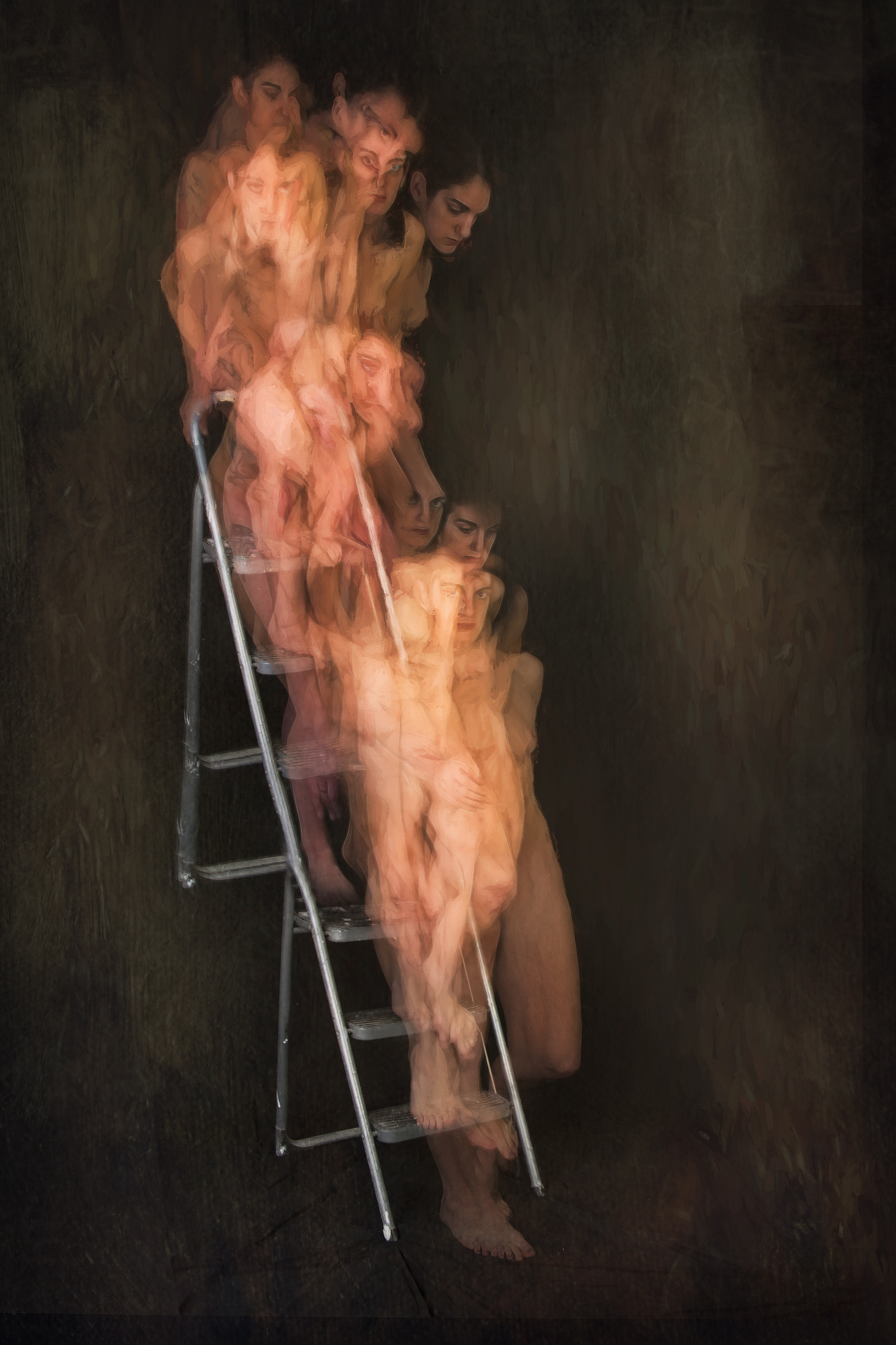The artist Marcel Duchamp created a furor in 1912 with his painting Nude Descending a Staircase, No. 2. This painting, which was rejected at the time as too avant-garde even by the Cubist movement, is an abstraction of the motion of a nude female figure coming down a staircase. In time, the Duchamp painting would come to be regarded as one of the key modernist classics.

My homage to the Duchamp painting is an abstraction of a nude descending a ladder. Les Desmoiselles and Gates after Rodin are two other images of mine where I’ve used comparable techniques, in part with visual references to famous art works in mind.
To make Nude Descending a Ladder I started with a series of in-camera multiple exposures, using studio strobes and a black background. Each multiple exposure had eight or nine images. I used my camera’s auto-gain setting to make sure that each multiple exposure was properly balanced across the range of individual exposures that were combined in the camera.
In post-production, I combined the best two of these images, one for the upper part of the ladder, and one for the lower part. I then worked to add a painterly effect to the image, using LAB color in Photoshop, Nik Color Efex, and the Topaz Adjust, Glow, Impression, and Simplify plugins. Finally, I added a textured background with light brush strokes to the image.
Duchamp was making a point with his Nude Descending a Staircase—that once you break the bonds of reality there really are no limits, and there is no call for the art-world’s political correctness police to say that one abstraction rather than another is too untethered from reality.
Besides the visual reference to the Duchamp painting, I am making a somewhat analogous point in my Nude Descending a Ladder. I’ve been criticized by establishment figures in the photography world because my images and prints “don’t look anything like photographs”—by which is meant the chemistry-based photography of the twentieth century. In other words, supposedly my images are not art-world politically correct photography.
Historically, going back to the birth of photography, photography was thought to depict “reality”, and the fact that photography was (erroneously) seen as creating an accurate rendition of the world is a large part of what freed painting from its orthodoxy. Painters no longer felt their purpose was to fulfill the role of showing “what was really there”. I use quotes around “what was really there” because as modern discourse has made clear this is not possible in any useful sense, and many paintings more served the role of hagiography, that is to say, were intended to embellish the reputations of the patrons that paid for them, rather than any accurate function of rendition (this, of course, remains the purpose of much portraiture to this day).
Freeing artists from the recitative need to show reality led to impressionism and later, more abstract, movements. The new role of art was first about seeing the world abstractly, and then more recently about ideas.
The consensus view that (in its turn) photography is an art form, and not something that slavishly reproduces “what is there” didn’t gain general acceptance until the closing years of the twentieth century, and then only as a new technology and art form—digital photography—was already on the horizon.
The new orthodoxy, and the one expressed by the statement that my images “aren’t really photography” is that a photo should be something coming out of the camera, without undue manipulation in post-production, and that these images should look like the photos of the past.
However, we do not know what the photos of the future will look like, but one thing is certainly true—they will be different and have evolved from the art form as it is now, and has been. So trying to copy the vision of the past without incorporating the gifts of technique from technology in the present is an exercise in futility, and one that is doomed to the dustbin of history.
Digital techniques have freed us from the orthodoxy of the camera, just as in the past the camera freed painters from the orthodoxies of representational art. But once you go down the road of a new art from, in which digital manipulation joins with digital capture, there are no limits. In a world loose from its moorings, there should be no rules about how images are created, and what art forms a digital photo or digital image can look like—only the appeal and interest of the final images.
Click here to check out my Multiple Exposure series of images!
Pingback: Metamorphosis
Pingback: Dark Angel
Pingback: My Best of 2016